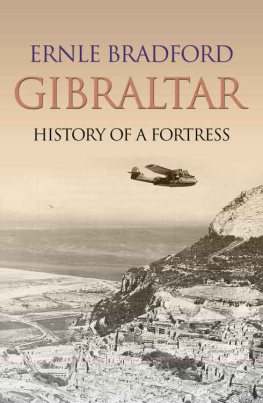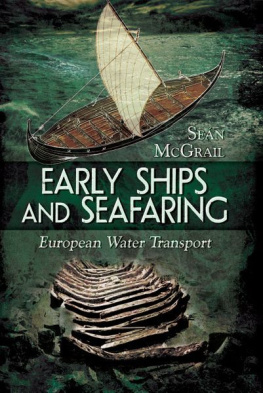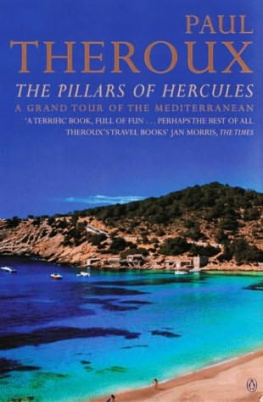Gibraltar: The History of a Fortress
Ernle Bradford
Copyright Ernle Bradford 1971
The right of Ernle Bradford to be identified as the author of this work has been asserted by him in accordance with the Copyright, Designs and Patents Act, 1988.
First published in the United Kingdom in 1971 by Hart-Davies.
This edition published in 2016 by Endeavour Press Ltd.
To Guy Bloomer, in memory of Gibraltar days
*
Nobly, nobly Cape Saint Vincent to the North-west died away;
Sunset ran, one glorious blood-red, reeking into Cadiz Bay:
Bluish mid the burning water, full in face Trafalgar lay;
In the dimmest North-east distance, dawned Gibraltar grand and grey;
Here and here did England help me: how can I help England? say,
Whoso turns as I, this evening, turn to God to praise and pray,
While Joves planet rises yonder, silent over Africa.
Robert Browning
*
The present state of Gibraltar is contrary to the whole spirit of post-war Europe.
General Franco
Table of Contents
Chapter One Rock and Sea
The strange and formidable Rock of Gibraltar has long been a symbol of all that is permanent and enduring. It is, indeed, a Rock of Ages.
To Mediterranean mariners of antiquity it stood as a warning mark, to tell them that they were at the close of the known world. Beyond it all civilization ended and possibly even the earth itself. Many centuries later, it was seen as the sally-port into Europe, the bridge across which the Moors stormed into Spain and the Christian continent out of Moslem Africa. Lastly, after the opening-up of the oceanic trade routes, it became the point where all of them converged to enter the Mediterranean. It is hardly surprising, then, that the Rock, and the whole area surrounding it, became imbued first with myth and legend, and then with history. Many battles have been fought beneath its shadow.
A four-faced Janus, Gibraltar looks out westward to the Atlantic, southward to Africa, and eastward into the Mediterranean. To the north it gazes towards Spain and Europe. This is, indeed, one of the great crossroads of the earth.
Less than three miles long by three quarters of a mile wide, the Rock is one of those natural phenomena which have acquired an importance out of all proportion to their actual size. Two accidents of nature account for this: firstly its geological structure, and secondly its geographical position. This immense rock, for such it is, rising to a maximum height of 1400 feet, is a jagged mass of Jurassic limestone which was formed on the bed of an immense ocean, during that phase of the worlds history which has been called The Age of Reptiles. The ocean, which covered a large part of modern Europe and the Mediterranean basin, was stocked by innumerable turtles, vast icthyosaurs and plesiosaurs, as well as by countless fish that were beginning to approach to their modern forms. Crustaceans and long-tailed lobster-like creatures; the catfish; and the ancestors of the sturgeon; all these formed part of the life of Tethys, as the ocean has been called after the Greek sea-goddess who was reputed to be the daughter of Earth and Sky. Molluscs and Cephalopods, sponges and corals, all contributed over the millennia to form out of their bony skeletons and frames a deep deposit on the ocean floor.
Looking at the Rock today, it is difficult to imagine that it represents the death of billions of creatures, all once vivid with life. But the time came when the earths surface shrank, and the Atlas mountains of North Africa and the Sierra Nevada of Spain were driven towards one another. When this occurred, the former seabed, at the junction of what is now the straits, was thrust up into the sunlight. More millennia of sun and rain, wind and ice, tempered this marine deposit until it became the limestone that is so typical of the Mediterranean region as man knows it today. Geologically, perhaps, there is nothing especially remarkable about Gibraltar, but geographically there is for it is separated from the main body of Spain and, therefore, of Europe. It is basically an island probably indeed it once was for the sandy isthmus that connects it with the continent is, in geological terms, an innovation. In other parts of the Mediterranean, similar siltings have occurred. Monte Circeo, for instance, a little north of Naples and now united to the west coast of Italy by alluvial deposits washed down from the Tiber, was once, too, an offshore island. Its structure is very similar to Gibraltars.
Gibraltar is what is known as a bill; that is to say, the exact opposite to an inlet, where an arm of sea thrusts into the land. The bill, or rock of Gibraltar, is an arm of land thrust out into the sea. If this, and its geological structure, were all, then there would be nothing more to say about Gibraltar except that it is an interesting but not unique natural phenomenon. The Rock, however, is situated at the narrow entrance-mouth of the Mediterranean, and has thus acquired its unusual importance. It runs almost due North and South, terminating at Europa Point, and facing across the straits that bear its name towards Mount Ceuta on the Moroccan coast. At this point, less than fourteen miles of sea divide Europe from Africa.
In classical times Gibraltar was known as Calpe, and Ceuta as Abyla. (Both names seem to stem from Phoenician roots, the exact meaning of which has long provided a battlefield for Semitic scholars.) They were the famous Pillars of Hercules beyond which, as the dramatist Euripides wrote in the fifth century BC, there lies the end of voyaging and the Ruler of Ocean no longer permits mariners to travel on the purple sea.
This was poetic exaggeration, of course (or perhaps no more than geographical and historical ignorance). The Phoenicians, for certain, had long been penetrating into the Atlantic beyond the Pillars of Hercules, and possibly even the Minoans and Myceneans before them. It is likely, though, that it was the Phoenicians who first named Gibraltar and Ceuta the Pillars of Hercules, or rather of Melquart. He was their principal male deity and it was the Greeks and the Romans who later equated him with Heracles, or Hercules. It has been suggested also that these two great rocks at the mouth of the sea reminded them of the twin pillars in the temple of Melquart at Tyre. Tyre was the most important city in the Phoenician world and, since it was the Tyrians who were among the foremost navigators of antiquity, it is probable that it was a Tyrian who first, lifting his eyes at dawn as the mist peeled off the strait, cried out The Pillars of Melquart, Lord of the City!
The appearance and geography of Gibraltar have been best described in the Journal of the Geological Society (London 1878):
The extreme length of the Rock from the base of the cliff at the north front to Europa Point is only a little over and the promontory tapers somewhat gradually away from a breadth of 1,550 yards between Gibraltar and Catalan Bay to a width of 550 yards at Europa. The Rock shoots abruptly upwards from the low flat land at the north front in a fine mural precipice, the basal portion of which is partly concealed by a sloping curtain of debris and breccia. This precipitous wall culminates...at the Rock Gun (1,349 ft.) from which point the dividing ridge or backbone of the promontory extends southward in a sharp jagged arch, the dominant points of which are Middle hill (1,195 ft.), Signal station (1,294 ft.), heights above Monkeys Alameda (1,396 ft.), and OHaras tower (1,370 ft.). At the latter the ridge is sharply truncated, and succeeded to the south by the well-marked plateau of Windmill hill and Europa. From the Rock Gun to OHaras tower the dividing ridge presents to the east a bold escarpment, which is for the most part inaccessible, and in places almost vertical, the cliffs where they are lowest having a drop of not less than 300 or 400 ft., and of more than 1,000 ft. where they approach the sea on the north. From their base the ground falls rapidly away to the coastline at angles that vary from 300 to 40 The opposite slopes of the dividing ridge are not so abrupt, the only really precipitous portion that faces the west being the line of cliff that overlooks Gardiners road and Engineers road between the Moorish wall and the Mount. A low sandy plain, that does not average more than 10 ft. in height above the sea, connects the Rock with the mainland.
Next page

















